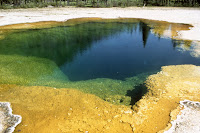(Continued from the preceding post)
 Several subspecies of the Desert pupfish (Cyrpinodon nevadensis ssp.) are located in small spring-fed ponds in Ash Meadows. Some subspecies occupy pools about the size of a small living room and this may be the entire habitat for this fish…the only place on Earth where they live-out their precarious existence. These pools may hold from several hundred to several thousand of these little fish. It doesn’t take much to make most of these fish ‘happy;’ just a little water with the right chemistry and temperature range and they seem to do quite well. I cannot tell how many times I have watched the little male pupfish in their blue nuptial colors claim a spot the size of a hand, a scoured-out depression made by a passing feral horse or burro, hold it against other males, attract a female with his colorful ‘dance,’ and spawn. The entire genetic history of the species is replicated in a depression not much bigger than a small sauce pan, if that big.
Several subspecies of the Desert pupfish (Cyrpinodon nevadensis ssp.) are located in small spring-fed ponds in Ash Meadows. Some subspecies occupy pools about the size of a small living room and this may be the entire habitat for this fish…the only place on Earth where they live-out their precarious existence. These pools may hold from several hundred to several thousand of these little fish. It doesn’t take much to make most of these fish ‘happy;’ just a little water with the right chemistry and temperature range and they seem to do quite well. I cannot tell how many times I have watched the little male pupfish in their blue nuptial colors claim a spot the size of a hand, a scoured-out depression made by a passing feral horse or burro, hold it against other males, attract a female with his colorful ‘dance,’ and spawn. The entire genetic history of the species is replicated in a depression not much bigger than a small sauce pan, if that big.  I recently saw a television special on the habitat and wildlife surrounding the Chernobyl nuclear reactor. Depending on who you listen to, biodiversity is either recovering or on the wane in that radioactive area. Regardless of what the data show, there does seem to be a robust population of some species. Humans are not allowed to spend much time in the area around Chernobyl. Is it the absence of humans that makes for the presence of other species? It is ironic to think that biodiversity may be able to exist with exceptionally high radiation counts but not with the human population counts that existed before the reactor meltdown.
I recently saw a television special on the habitat and wildlife surrounding the Chernobyl nuclear reactor. Depending on who you listen to, biodiversity is either recovering or on the wane in that radioactive area. Regardless of what the data show, there does seem to be a robust population of some species. Humans are not allowed to spend much time in the area around Chernobyl. Is it the absence of humans that makes for the presence of other species? It is ironic to think that biodiversity may be able to exist with exceptionally high radiation counts but not with the human population counts that existed before the reactor meltdown.
For additional information on some of the species mentioned refer to:
Baugh, T. 1981. Observations on the courtship and reproduction of the desert pupfish (Cyprinodon macularius. American Currents 7(3):15-18.
Baugh, T.M. 1981. Adapting Salt Creek pupfish (Cyprinodon salinus) to fresh water. Western North American Naturalist 41(3).
Baugh, T.M. and J. E. Deacon. 1983. Daily and yearly movement of the Devil’s Hole pupfish Cyprinodon diabolis Wales in Devil’s Hole, Nevada. Great Basin Naturalist 43(4):592-596.
Baugh, T.M. and J.E. Deacon. 1983. Maintaining the Devil’s Hole pupfish Cyprinodon diabolis Wales in aquaria. J. Aquariculture and Aquatic Sciences 3(4) :73-75.
Baugh, T. M. 1984. In search of the Salt Creek pupfish. Part 1. Freshwater and Marine Aquarium 7 (5): 34-35, 44-45.Baugh, T. M. 1984. In search of the Salt Creek pupfish. Part2. Freshwater and Marine Aquarium 7 (6): 31-33, 54, 56.
Baugh, T.M. and J. E. Deacon. 1988. An evaluation of the role of refugia in conservation efforts for the Devil’s Hole pupfish Cyprinodon diabolis Wales. Zoo Biology 7:351-358.


